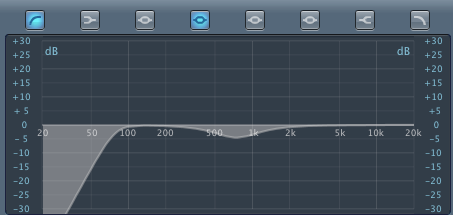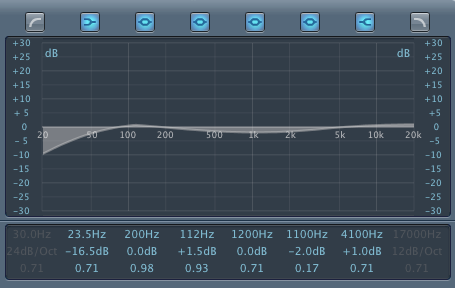How I Discovered EQ and Great Guitar Tones at the Same Time
Whenever I start creating a new mix for the first time, EQ is one of the first tools I go to if I have problems. For me EQ gives me a huge opportunity to craft the mix in a way that brings out the best in each of the individual instruments.
To be fair, if I can fix the problem with microphone placement or asking the musicians to change their settings or the way they are playing, that is always the first step. After all, garbage-in means garbage-out. It’s easier to get everything right the first time.
But if you’ve done everything you can in the physical space, the first place to start is always with equalization. Compressors are nice and gates are also helpful, but they can have large negative side effects when used improperly. Plus, they generally don’t have the surgical precision or power that my EQ has.
I first learned this lesson when I was learning to play electric guitar. In my early days I picked up some of those digital multi-effect pedals. They had distortion, overdrive, reverb, delay, chorus, and just about every other effect you could want. Like most guitarists, I became obsessed with my tone, specifically finding the balance of overdrive. Overdrive could make even the cheapest guitar sing, and I loved it.
But then I started recording and playing live. When I turned the guitar up in my monitors, it sounded really good. But when I had to listen back with all the other instruments, it just sounded bad. The distortion was too much. What sounded beautiful while sitting on my couch at home didn’t translate well at all to a full band setup. Everything was just muddy and muddled.
As I set out to find a solution to this problem, I began to discover the power of EQ. Up until this point, I had worked on some basic analog consoles with only a three band parametric EQ. At this point the church I volunteered at upgraded to a Mackie 32-4 VLZ Pro. Although this console isn’t mind-blowing, it had a feature that I’d never worked with: a sweepable midrange EQ.
Suddenly I could experiment with EQ on a new level. Taking my experience with trying to find a great guitar tone and then merging that with this new experience of a sweepable EQ, I began to realize just how powerful subtle EQ shifts could be. I could boost certain frequencies and cut certain frequencies to fundamentally change the way my guitar sounded. I could also reduce some key frequencies to help my guitar fit better with the vocal mix.
On electric guitars specifically, I was able to craft a tone that was both clear and cutting without being harsh. Finally I was on the path to having a great guitar tone, and EQ was the road that led me there.
About 99% of the time when I create a mix for a band live, the guitar player has too much overdrive on his or her guitar. They manage to wash away all the tone and their unique instrument’s ability with an excessive amount of overdrive. As an engineer this makes it difficult for me to get their instrument to shine through in the mix, plus a distorted guitar takes up way more space in the mix. If I could give one piece of advice to every electric guitar player, it’s this: you need have the overdrive you think you do.
But even when faced with a heavily over driver guitar. I first start with the EQ. What frequencies do I need and do I not need? Generally I roll off most of the low frequencies and take a notch out of the EQ between 300 Hz and 2 kHz. It depends on the instrument, microphone, amplifiers, and audio system, but this is usually a great place to start. Here is generally the EQ I start with for an electric guitar.

By taking off the low end, I help ensure that the guitar doesn’t interfere with the kick drum or bass guitar. I also try and take a “notch” out for the vocals so that they sit nicely in the mix. The beauty of notching the electric guitar in this way is that you maintain the tone the guitar player is going for, but you leave room for the vocals. When you mix this way, it can seem as if the voices are coming out of the middle of the mix versus trying to sit on top of it.
You also have to be careful not to take too much out. If you EQ out too much of that key midrange, you’ll have a guitar that sounds rumbly and lacks definition. It won’t carry like it is supposed to, and you’ll need to turn it up louder in the mix to get anything useful from it.
It’s a delicate balance and one that is always a challenge to get exactly right. But once you nail it, the guitar will sound great and the vocals will have plenty of room to shine.
Although I’ve since ditched most of my digital pedalboard and have upgraded to analog gear on the guitar side, I still spend some time playing, mixing, and recording guitars. And parametric EQ is now my best friend. Whether I’m trying to get a Jimi Hendrix or SRV start sound, a delayed U2 echo, or anything else, I always reach for the EQ first and the overdrive second.
As an engineer EQ is one of my most powerful tools. As a musician, it’s a lifesaver.
Although every guitar is different, here are my current settings in logic for one of my guitars. The particular guitar these settings are for is an old Squire ’51. I paid $100 for the guitar about 7 years ago. It has a humbucker in the bridge and a single coil in the neck position. Using just a hint of overdrive, I can really make it sing. I prefer to play through Apple’s Logic so I can get the tone exactly how I like it. When I mix electric guitars as part of a larger mix, I never want them to cover up the vocals, so I generally take just a few db about between about 300 Hz and 2 kHz. This keeps the guitar tone intact, but creates a nice pocket for the vocals to reside in. I also nearly always roll off the low end on a guitar. If you have a bass guitar, you generally don’t need it. Here is the setup I saved for one of my own guitars for recording.
When I mix electric guitars as part of a larger mix, I never want them to cover up the vocals, so I generally take just a few db about between about 300 Hz and 2 kHz. This keeps the guitar tone intact, but creates a nice pocket for the vocals to reside in. I also nearly always roll off the low end on a guitar. If you have a bass guitar, you generally don’t need it. Here is the setup I saved for one of my own guitars for recording.

